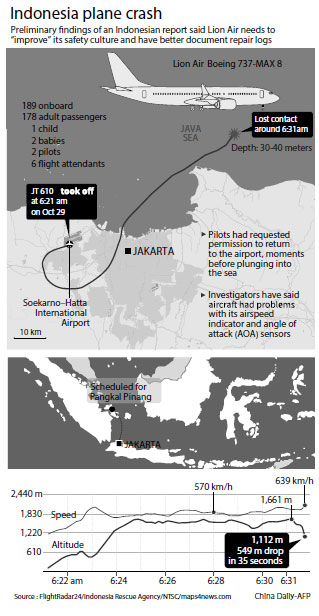Report finds fault with airline's safety measures in crash
JAKARTA, Indonesia - A report based on black box data from an Indonesian Lion Air jet that crashed last month cites equipment failures and the airline's safety measures as factors in the disaster.
The data reported on Wednesday showed the pilots of the Boeing 737 MAX 8 struggled to maintain control as an automatic safety system repeatedly forced the plane's nose down. The report repeats recommendations that pilots be better versed in emergency procedures and aware of past aircraft problems.
The probe into the crash has focused on whether faulty information from sensors caused the accident. The new 737 MAX 8 plunged into the Java Sea on Oct 29, killing all 189 people on board.
The report from Indonesia's transport safety agency did not pinpoint a definitive cause of the accident, with a final report not likely to be filed until next year.

Nurcahyo Utomo, an investigator for Indonesia's National Transportation Safety Commission, told reporters in Jakarta on Wednesday that four of the crashed aircraft's previous flights had experienced technical problems, with two showing no such difficulties.
He said investigators were trying to understand what maintenance workers had done to try to fix the problems and if there were other steps that should have been taken.
"Even if the pilot did not have time to meet with the engineer, he should be able to know what problems were experienced by the aircraft before," Utomo said.
In a statement, Boeing played up the possibility of pilot error.
"As our customers and their passengers continue to fly the 737 MAX to hundreds of destinations around the world every day, they have our assurance that the 737 MAX is as safe as any airplane that has ever flown the skies," it said in a statement.
The aircraft manufacturer noted that the report on the details of the doomed flight cited actions by the flight crew that led to the crash and that the airline's maintenance work and procedures had failed to fix the aircraft's repeated problems.
The findings will heighten concerns there were problems with key systems in one of the world's newest and most advanced commercial passenger planes.
Investigators have previously said the doomed aircraft had problems with its airspeed indicator and angle of attack (or AOA) sensors, prompting Boeing to issue a special bulletin telling operators what to do when they face the same situation.
The report confirmed that initial finding, saying the plane's data recorder detected an issue with the AOA.
It also said the plane's "stick shaker" - the steering-wheel like handles in front of the pilots that vibrates to warn of a system malfunction - was "activated and continued for most of the fight".
An AOA sensor provides data about the angle at which air is passing over the wings and tells pilots how much lift a plane is getting. The information can be critical in preventing an aircraft from stalling.
Ap - Afp
(China Daily 11/29/2018 page11)














